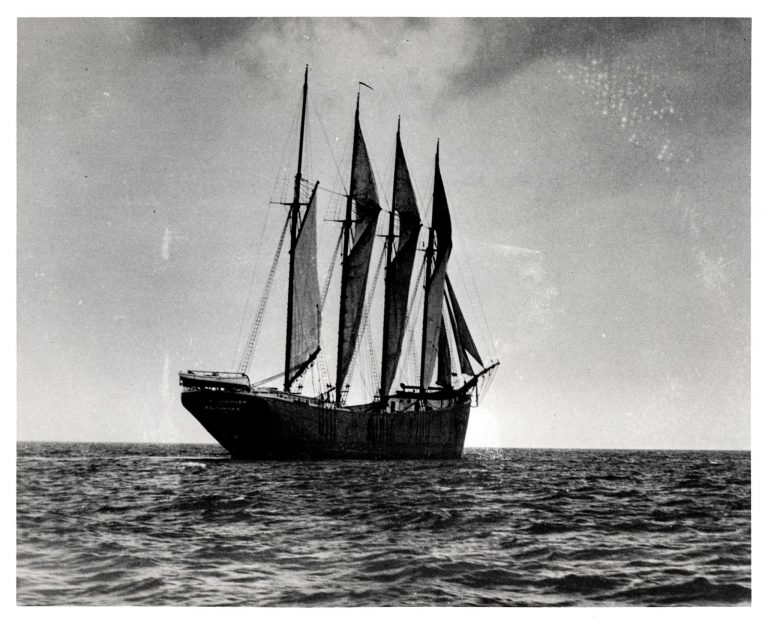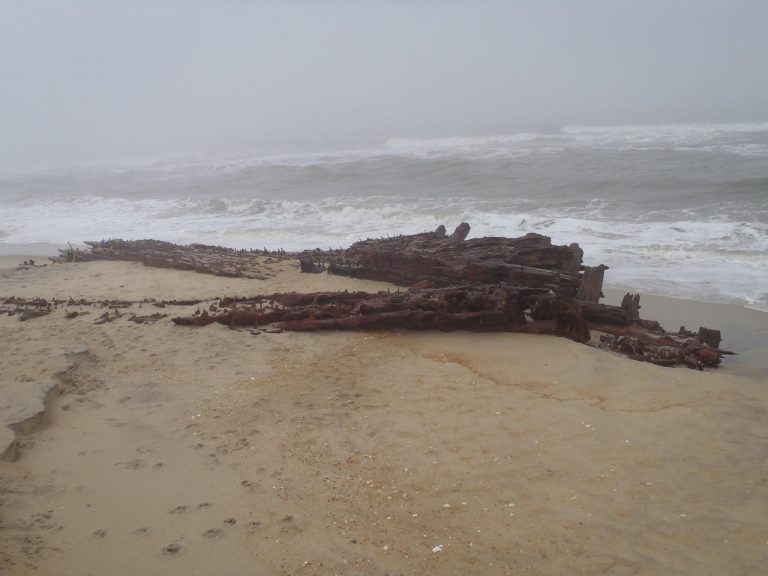Today the George A. Kohler is the charred skeleton of a once proud ship resting on the beach a few miles south of Salvo. A four-masted schooner, she was, perhaps, the last gasp of a maritime way of life.
The Kohler began her life in Wilmington, Delaware on November 13, 1919. Built by the American Car & Foundry Company, she had a different name when launched, beginning life as the Charles S Gawthrop. The ship’s name changed in 1926 to the Kohler, probably because of a change in ownership.

When launched, the ship was a bit of a hybrid—built as a 4-masted schooner, she had twin diesel auxiliary engines. She was a large sailing vessel—230’ in length rated as 1488 gross tons.
Initial sea trials showed the Gawthrop could hold a speed of 9.12 knots (10.5 mph) for an extended period of time using her engines. Not quite as fast as the steamship of the day, but a respectable speed.
Although the age of the steamship was firmly established by 1919, schooners designed to carry cargo were still being built as late as 1925. Although neither as fast as the steamships nor able to carry as much cargo, they had one big advantage over the fuel-powered ships that were ruling the seas.
Their operating costs were a fraction of the cost of a steamship. If they could only carry half the cargo of a steamship, they could still do it at one quarter the price.
The Kohler’s last voyage began on August 20 1933 in Baltimore. She was bound for Haiti and sailing under fair skies and calm conditions as she made her way out of Chesapeake Bay.
It is not known if the ship’s master, Captain George Hopkins, knew of the reports of a powerful hurricane to the south of Bermuda. He may have known of the storm and decided that his ship was capable of weathering a hurricane. It is also possible that he knew of the storm, but also knew that storms very rarely track west-northwest from Bermuda.

After leaving the Chesepeake Bay, the next report of the ship finds it stripped of its sails and reeling helplessly in the surf on the morning of August 23. She was spotted about two miles south of the Gulf Shoals Coast Guard Station. The station is no longer there but it would have been on the south end of Salvo.
The ship soon beached hard on a sandbar—almost on the beach itself. She was flying distress flags and firing flares, but the weather was so bad that a rescue was impossible.
She sat there all night, embedded in the sand, waiting for the rescue that did come the next day. The crews of Gulf Shoals and Chicamacomico combined to bring Captain Hopkins, his wife, seven-member crew, and a dog ashore using a Lyle gun and a breeches buoy
The Kohler was high on the beach and so embedded in the sand that there was no hope of ever reflecting her.
The storm that doomed the Kohler came to be known as the Great Chesapeake-Potomac Storm. Most of the literature about the storm places landfall just to the north of Nags Head, probably Kill Devil Hills or Kitty Hawk. The storm then turned north, with the eye passing over Currituck Sound and making a second landfall at Knotts Island.
The flooding from the storm in the Hampton Roads area was catastrophic; in some areas, the high water mark of the storm has not yet been matched.
After leaving Hampton Roads, the storm took aim at our nation’s capital, flooding and damaging property as it rampaged north and east, finally exiting in Maine as a powerful extratropical system.
Along the Outer Banks and Eastern Shore of Virginia, the damage to the Coast Guard stations that dotted the coast was so great that Commander of the Seventh Coast Guard District, W. W. Bennet, took his men to task for what he saw was their failure to heed Weather Service warnings and secure their facilities.

On the Outer Banks, the story of the Kohler was not quite over. The ship was sold for salvage for $150. On Outer Banks, though, residents continued a long tradition of salvaging what they could from any shipwreck.
According to a National Park Service study of the villages of Hatteras Island, what is now the Lighthouse Church in Salvo was built from the wood of the ship.
“The congregation met in peoples’ homes until a church was built in 1935…from timbers of the G.A. Kohler shipwreck of 1933. The first service was held October 6, 1935,” the studies’ authors wrote.
During WWII, with the Kohler still deep in the sands of Hatteras Island, the ship was burned for the metal in her fittings. We were unable to find a date for that, but it was probably prior to 1944 when the Great Atlantic Hurricane passed over Cape Hatteras.
